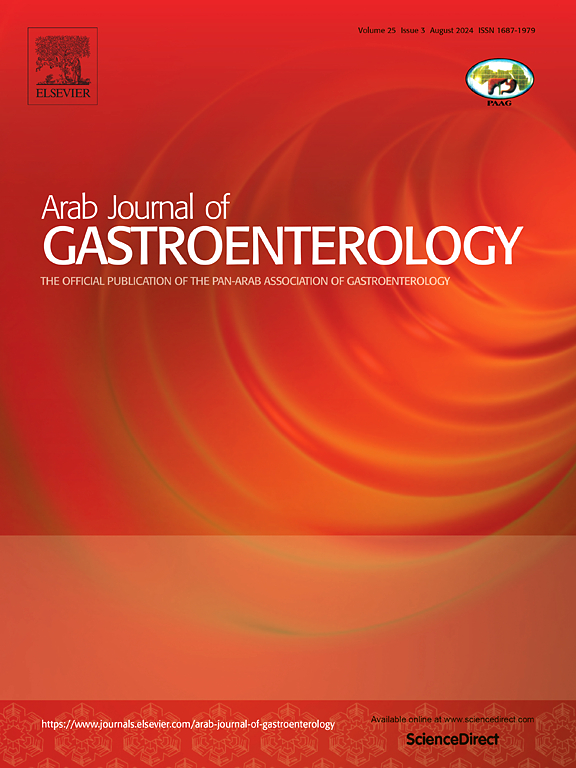The efficacy of removal of animal milk from the diet in functional dyspepsia: A cross-sectional study
IF 1.1
4区 医学
Q4 GASTROENTEROLOGY & HEPATOLOGY
引用次数: 0
Abstract
Background and study aims
We aimed to investigate the effect of removing milk and dairy products from diets on functional dyspepsia (FD) symptoms, as the aetiology remains unclear and new management approaches are needed.
Patients and methods
This cross-sectional cohort study included 120 patients, with a mean age of 42.5 ± 12.3, of whom 77 (64.2 %) were female, with FD diagnosed by the Rome IV criteria. Patients were divided equally into two groups: those who eliminated milk and dairy products from their diet under the advice of a dietician without medical treatment and those who did not. The severity of symptoms was assessed using the gastrointestinal symptom rating scale (GSRS) at the beginning and end of a one-month period.
Results
The restricted and unrestricted diet groups showed no significant differences in age, body mass index, symptom frequency and duration, weight changes, FD subtype, and gastroscopy results (p > 0.05). The diet group had more female patients (p = 0.01) and higher GSRS scores at the beginning (p = 0.01) but similar scores at the end of the study (p = 0.99). After one month, both groups had improved GSRS scores (p = 0.01), but the diet group had a more significant decrease in total symptom scores (p = 0.01) and in 7 of the 15 subsets (p < 0.05).
Conclusion
Of the 120 FD patients who followed up for one month, 60 who removed milk products had a more significant reduction in GSRS symptom score and 7 of the 15 symptom subset scores than 60 patients receiving an unrestricted diet.
从饮食中去除动物奶对功能性消化不良的疗效:一项横断面研究。
背景和研究目的:我们旨在研究从饮食中去除牛奶和乳制品对功能性消化不良(FD)症状的影响,因为其病因仍不清楚,需要新的治疗方法:这项横断面队列研究共纳入 120 名患者,平均年龄为(42.5 ± 12.3)岁,其中 77 人(64.2%)为女性,根据罗马 IV 标准确诊为功能性消化不良。患者被平均分为两组:在营养师建议下从饮食中剔除牛奶和乳制品而未接受药物治疗的患者和未剔除牛奶和乳制品的患者。在一个月期间的开始和结束时,使用胃肠道症状评分量表(GSRS)对症状的严重程度进行评估:限食组和非限食组在年龄、体重指数、症状频率和持续时间、体重变化、FD亚型和胃镜检查结果等方面无明显差异(P > 0.05)。节食组女性患者较多(p = 0.01),开始时 GSRS 评分较高(p = 0.01),但研究结束时评分相似(p = 0.99)。一个月后,两组患者的 GSRS 评分都有所改善(p = 0.01),但饮食治疗组的症状总分(p = 0.01)和 15 个子组中 7 个子组的症状总分(p = 0.01)下降更明显(结论:饮食治疗组的症状总分下降更明显(结论:饮食治疗组的症状总分下降更明显(结论:饮食治疗组的症状总分下降更明显):在随访一个月的 120 名 FD 患者中,与 60 名接受无限制饮食的患者相比,60 名去除牛奶制品的患者的 GSRS 症状评分和 15 个症状子集中 7 个子集的评分下降更为明显。
本文章由计算机程序翻译,如有差异,请以英文原文为准。
求助全文
约1分钟内获得全文
求助全文
来源期刊

Arab Journal of Gastroenterology
Medicine-Gastroenterology
CiteScore
2.70
自引率
0.00%
发文量
52
期刊介绍:
Arab Journal of Gastroenterology (AJG) publishes different studies related to the digestive system. It aims to be the foremost scientific peer reviewed journal encompassing diverse studies related to the digestive system and its disorders, and serving the Pan-Arab and wider community working on gastrointestinal disorders.
 求助内容:
求助内容: 应助结果提醒方式:
应助结果提醒方式:


